- Know what you want before you get estimates – its best to have a detailed drawing of the project with exactly what you want and the materials you expect to use. If you leave the ideas up to a contractor, chances are your project will get much bigger than expected.
- Interview at least 3 contractors – I can’t stress this enough. Make sure they’re licensed and have all the necessary insurances. If available, go check one of their current projects and see how they conduct themselves in the field. Is the job site clean and a safe working environment?
- Choose the right Contractor for the right job – You need to make sure your project is within their ability. A contractor that specializes in bathroom remodels might not be your best bet for a complete house addition which requires understanding foundations, loads, maximum span, roof lines, etc.
- Ask what will be done by employees and what will be done by subs – Understanding the hierarchy of the project will keep delays to a minimum.
- Expect the contractor to be too busy to start now – A general rule of thumb is a busy contractor is usually a good contractor.
- Signed Detailed Contract – The most important piece of working with a contractor. The more detailed, the better protection for both parties. Should include:
- Detailed Drawing
- Cost Estimates
- Scope of Work
- Critical Paths
- Change Orders
- Payment Schedules
- Budget Overruns
- Delays
- Lien Waivers
- Don’t pay more than 30% down when you sign the contract. – You don’t want the contractor to use your money to finish another job
- Get Proper Permits – The quickest way to get a project shut down is to start without the proper permits. Your Contractor should know all the local building inspectors.
- Negotiate hours of work and ground rules at the beginning – If you’re living in the house while the project is going on, you need to have an understanding of when work begins and ends each day. You’re world is going to be turned upside down, so a little privacy goes a long way.
- Verify Insurance – Verify Insurance – Verify Insurance – Your Contractor must have workers comp and general liability insurance before any work should be performed.
- Expect 10-15% over budget – Your contractor can’t see behind walls so expect hidden problems up front.
- Talk to your Contractor often – The best way to make sure your project stays on time and within the scope of work.
- Get Lien Releases and Receipts for materials
- Don’t make final payment until 100% satisfied – A punch list should be completed with the contractor to include timely corrections.
Category: How To
3, 4 , 5 Method to Find Perfectly Square Corner
In any type of carpentry project, from building decks and sheds to laying out an entire house, it’s vital your walls are plumb and level and your corners are square. Levels will take care of the first two,, but what about squaring your corners?
If you remember your high school geometry class, you may remember The Pythagorean Theorem which states:
The square of the hypotenuse (side opposite right corner) is equal to the sum of the squares of the other two sides or A2 + B2 = C2
Let’s put this theory to use in layman’s terms using the 3, 4, 5, method, which is used on our sites daily in layout and to check block and framing work.

While checking our block mason’s work prior to pouring our pad, I’ll use my speed square for quick reference as well as the 3, 4, 5 method to check his corners. The 3, 4, 5, method is quick and easy to use and ensures all your corners are square. You can use any increments including inches, feet, or centimetres and any multiplier of the number you choose, and many times we do for larger layouts, but they must be consistent. (i.e., A = 3’ x 2’ =6’ , B = 4’ x 2’ = 8’ & C = 5’ x 2’ = 10’) For simplicity terms, I’m using 3’ , 4’, and 5’ as my numbers, so let’s get started
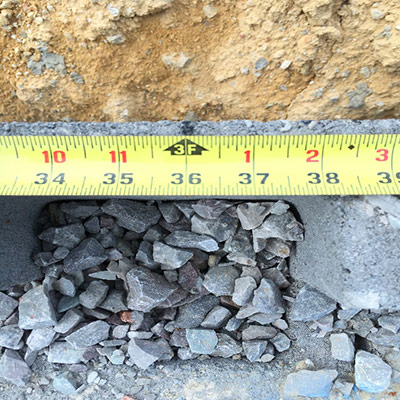
Step 1 – Starting from the corner point, pull a tape measure down the first wall or line A and mark 3’.

Step 2 – Starting from same corner, pull a tape measure down the second wall or line B and mark 4’.
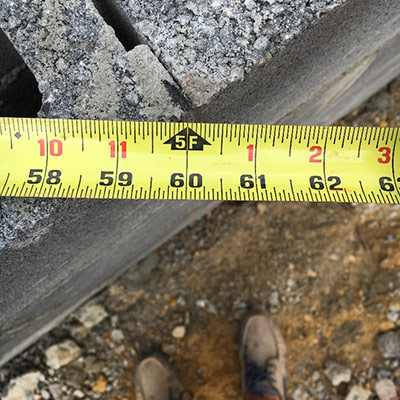
Step 3 – Now pull a tape measure between your two marked lines which is your hypotenuse or line C and your tape should read 5’. If it’s more than 5’, the corner is not square and outside 90 degree. If it’s less than 5’ then your corner is under 90 degrees. My tape reads exactly 5’ so I know my corner is exactly square.
Warm Weather Checklist
As the warm weather has arrived and we spend more time outdoors, it’s important to take some time and make sure your house and property is looking its best before those Summer celebrations begin.
- Gutters and Downspouts – leaves and debris collect through the winter in many instances clog downspouts. Remove any debris and rinse both gutter and downspouts to make sure the water is going where it’s supposed to. If your downspouts get clogged and allow water to back up, you will face potential rot problems in your fascia and soffit. This is a good time to visually inspect all your soffits as well.
- Inspect Your Roof – If your roof is a moderate pitch and you’re able to walk it without too much risk, you’ll be able to get up close and personal for a good visual inspection. However, if it’s cutup with high pitches, a visual from the ground will suffice. Check for broken or raised shingles. If it’s raised, chances are you have a nail pop and a potential leak. Check the valleys for damaged shingles and check all flashing. If you have a fireplace, check cricket to make sure its diverting the water flow and make sure all flashing is in tack. Check any caulking as well and replace as needed.
- Siding – Check all siding for broken pieces and replace as needed. This is a good time to give your siding a good pressure washing. I also like to add a “green” mildew cleaner to the process to make sure all my siding is super clean before I replace missing caulk and do any paint repairs.
- Window and Door Sills – Check for rot and replace as needed. Check all caulk around sills and replace where needed. This is one of the biggest culprit areas for lost energy so make sure all your window and door sills are tight and well-sealed.
- Inspect Attic – Inspect your attic for any water stains and any open areas around vents which sometime allow for unwanted guests. Look up and inspect your roof decking for any dark stains. If you see stains, you probably have a leak of some sort. Any leak is a bad leak. At this point, it’s best to have a tape measure handy so you can measure to walls and coordinate the location to the roof so you can try and find the source of the leak. Winter months are not only dark and cold, but they also seem to lend themselves for attic squirrel invasions, so check to make sure you don’t have any open areas around gable vents and soffits. A squirrel can fit through a hole that’s just a tad bit larger than a quarter, and once you get them in your attic, they can cause a tremendous amount of damage, not to mention their food source and feces will be everywhere.
- Check your Crawl Space for Water and Mold – Throw on some old coveralls and grab your flashlight cause it’s time to get dirty. Crawl under your house and inspect your entire crawl space for water and any visible mold on floor joists and floor decking. Make sure any vents are unobstructed so there is enough air flow to keep your crawl space dry as a bone. Crawl spaces and basements are the biggest draws for potential mold growth so make sure you keep these areas clean and dry.
- Decks – You should pressure wash your deck every year and seal it every 2-3 years. Make sure there are no nail pops or screws protruding and check for rot. Check for splits in deck boards and replace as needed. Decks are a big hang out area through the Summer and many times you’re on them barefooted, so make sure any potential hazards to your feet are kept to a minimum. Stumping your toe on nail pop ups and splinters in your feet are a great way to ruin a fun time outdoors
- Air Conditioner – Change all your filters and have your system cleaned and serviced by a professional. When you need it, you want to make sure it’s working as efficient as possible. You should change your furnace filter every 30 days
- Foundation – Clean all leaf and gardening debris from around your foundation. Prune all foundation plants and pull mulch away from edge of house. Mulch holds water and you don’t want water against your foundation. Visually inspect for any cracks or settling.
- Lawn Sprinklers – Turn your sprinkler on and run through your different zones to make sure they are all working properly with the desired amount of time. Check all pop-up heads to make sure they are spraying where you want them to.
Acid Staining Concrete
Reactive Acid Stain applied on a concrete floor can add a marbling look and a depth of color not available in other flooring products. It’s a great project for basements, converted garages, and even exterior concrete like porches and sidewalks. While it’s a time consuming project, it’s not out of the realm of most DIY’ers with proper planning. You can get as creative as you would like, but for this exercise we used 4 different colors of stain and cross sprayed them against each other to give a mottling effect. The lime deposits in the concrete react with the hydrochloric acid in the stain pulling out the different hues of a color, making the floor look like a piece of natural stone with different veins of color running throughout.
Before
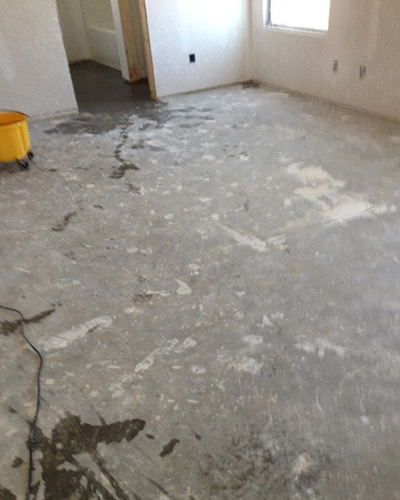
After

Before
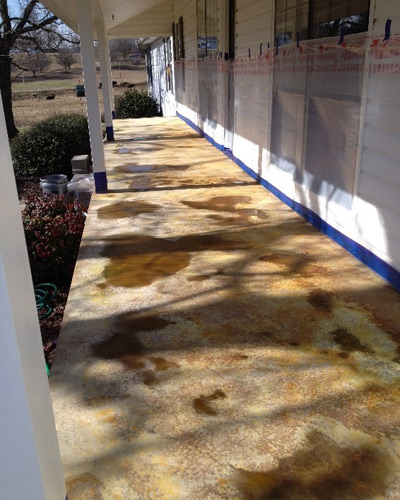
After
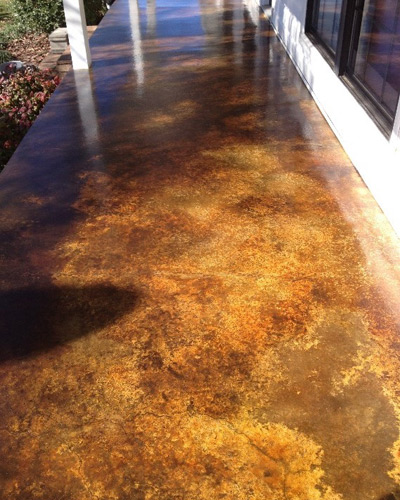
Materials Needed
- 2 Gallon Plastic Garden Sprayer with all plastic parts including wand
- Large Wet/Dry Vac
- Good quality blue painters tape
- Plastic Painters Sheeting
- High Speed Floor Polisher – found at most rental centers
- 2-3 Coarse Nylon Grit Scrubber Pads
- Acidic Cleaner
- TSP – Trisodium Phosphate
- Large Industrial Mop and Bucket
- Protective Eye Goggles
- Respirator
- Rubber Gloves
- Knee Pads
- Acid Stain
- Ammonia for neutralizing stain
- Sealer
Total Estimated Cost for Materials for approximately 1,000’: $450-$700 depending on type of sealer used
STEP 1. CHECK AND CLEAN CONCRETE
Check your concrete floor for visible contaminants like oil and grease stains, paint, caulk, or mastic left from an existing floor. For small paint, caulk, or spackling contaminants, we use a putty knife and a chemical paint stripper. For larger contaminated areas we use a high speed floor scrubber with an 80 grit sandpaper disk or occasionally diamond tip scrubber attachments if the floor is in bad shape.
Also check to see if the floor has a sealer on it, because if there is a sealer, the stain can’t penetrate the concrete. Take a spray bottle filled with water and check different areas of the floor to be stained. If the water beads up and doesn’t soak into the concrete, there is a sealer present which has to be removed. There are many products on the market for cleaning concrete and getting it ready for acid staining.
- Acidic Cleaners- gets rid of staining, dirt contaminations and other contaminants that can be broken down by the acid in the cleaner.
- Alkaline Cleaners- gets rid of oil, grease, and other hard to remove hydrocarbon based stains
- PH-Neutral Cleaners- A mild cleaner usually used indoors for already sealed floors without dirt contaminant


Once you have properly cleaned the floor, again check for contaminants because the floor has to be completely clean and free of all contaminants in order to properly accept the acid stain. This is the most important part of the project because if you miss any oil and grease stains, paint, mastic, or caulk, they will be highlighted and stick out like a sore thumb in your finished work.
STEP 2 – PREPPING BASEBOARDS AND WALLS
Take a good quality 3”-4” blue painters tape and tape the entire baseboard. Once the baseboard is taped, we use a 6’ wide plastic painters sheeting and overlap the baseboard and tape it again to ensure no stain seeps in and stains the baseboard or wall.
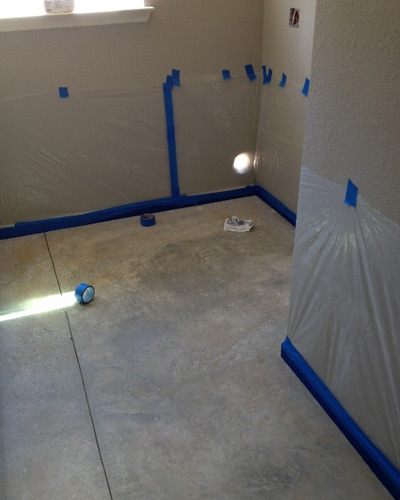
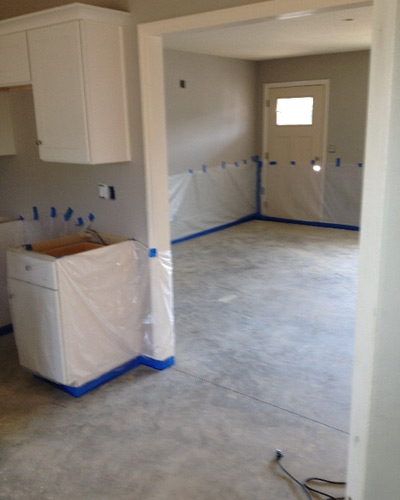
STEP 3 – APPLYING ACID STAIN
Once your floor is clean and dry, the fun part of the project begins. Dilute your stain with water with the following rates.
- Hand-trowelled floors – mix 1 part stain to 4 parts water
- Machine-trowelled floors – mix 1 part stain to 1 part water
Mix your stain in a 2 gallon plastic garden sprayer and it’s important to note that you pour the stain in the water instead of pouring water into the stain. This ensures proper mixture of the stain.
Hold the sprayer tip about 18” from the floor and start spraying with a figure 8 pattern until the area you want to spray is completely wet, but not puddling. In this step of the project we use 2 people spraying slightly different colors across each other’s spray pattern, which gives it the mottling or marbling effect. Once the 1st coat is dry, usually about 1 hour, apply 2nd coat and repeat the process until you’ve reached the color you desire. Let the stain sit for about 3-4 hours total so it has time to react with the concrete’s lime deposits. Neutralize the stain by mixing water and ammonia in your garden sprayer and spray the entire floor. Use a mop or fine bristle push broom to work in ammonia mixture and then vacuum up the residue. Then take clean water and mop the floor several more times until the floor is completely clean and free of all residue. It’s important to note, at this point in the project, it’s tough to know what the finished floor will look like without the sealer on it. The sealer will make the floor pop and greatly enhance the colors. To give you an idea of the finished look, you can wet a small area of the floor with water. If you’re happy with the color schemes, it’s important to let the floor dry completely before applying a sealer
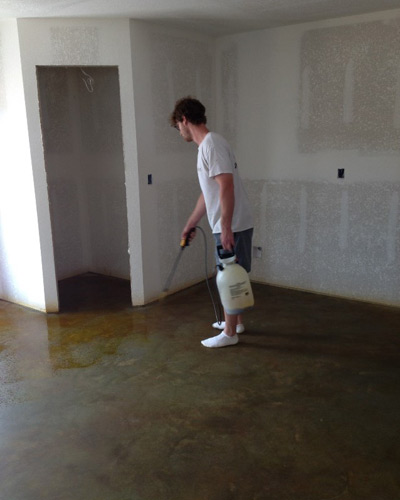

STEP 4 – APPLYING SEALER
The 3 main type of concrete sealers used when staining concrete;
Acrylic Sealers – For both exterior and interior projects. Acrylics form a thin protective film on the concrete surface and are available in both water and solvent based. They are typically used when easy application and economy are important. They are available in many sheens and solvent based acrylics generally enhance colors greater than water based sealers. They provide good UV protection but are softer sealers, so several thin coats need to be applied, and yearly maintenance with a good floor polish will keep your floors looking good
Polyurethanes – For both exterior and interior projects where high foot traffic is present like restaurants and retail shops. Nearly twice as thick as acrylics and produce a very durable chemical and abrasive protective coating and are available in both water and solvent based formulas. Available in a range of sheens and finish is transparent and non-yellowing. The downside of Polyurethane sealers is they are more difficult to apply because of their quick dry time.
Epoxies – Usually limited to Indoor use due to non UV protection which may impart a yellowing effect if exposed to sun. Produce a hard long wearing abrasion resistant flooring, but most difficult top apply because most are two-component products mixed prior to application. On floors in high-traffic areas, Cement-based overlays, and Concrete countertops.


While using Acid Stain on concrete is a fun and rewarding project, it can be a bit overwhelming at time, so a great resource for tips and more in-depth information can be found via the internet at The Concrete Network.






